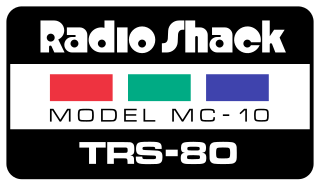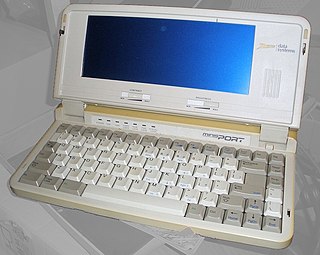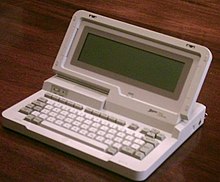
The TRS-80 Micro Computer System is a desktop microcomputer launched in 1977 and sold by Tandy Corporation through their Radio Shack stores. The name is an abbreviation of Tandy Radio Shack, Z80 [microprocessor]. It is one of the earliest mass-produced and mass-marketed retail home computers.

The RadioShack TRS-80 Color Computer, later marketed as the Tandy Color Computer and sometimes nicknamed the CoCo, is a line of home computers developed and sold by Tandy Corporation. Despite sharing a name with the earlier TRS-80, the Color Computer is a completely different, incompatible system and a radical departure in design and compatibility with its Motorola 6809E processor rather than the Zilog Z80 earlier models were built around.

VisiCalc is the first spreadsheet computer program for personal computers, originally released for Apple II by VisiCorp on October 17, 1979. It is considered the killer application for the Apple II, turning the microcomputer from a hobby for computer enthusiasts into a serious business tool, and then prompting IBM to introduce the IBM PC two years later. More than 700,000 copies were sold in six years, and up to 1 million copies over its history.
Kaypro Corporation was an American home and personal computer manufacturer based in San Diego in the 1980s. The company was founded by Non-Linear Systems (NLS) to compete with the popular Osborne 1 portable microcomputer. Kaypro produced a line of rugged, "luggable" CP/M-based computers sold with an extensive software bundle which supplanted its competitors and quickly became one of the top-selling personal computer lines of the early 1980s.

The Commodore Plus/4 is a home computer released by Commodore International in 1984. The "Plus/4" name refers to the four-application ROM-resident office suite ; it was billed as "the productivity computer with software built in".

The Tandy 2000 is a personal computer introduced by Radio Shack in September 1983 based on the 8 MHz Intel 80186 microprocessor running MS-DOS. By comparison, the IBM PC XT used the older 4.77 MHz Intel 8088 processor, and the IBM PC/AT would later use the newer 6 MHz Intel 80286. Due to the 16-bit data bus and more efficient instruction decoding of the 80186, the Tandy 2000 ran significantly faster than other PC compatibles, and slightly faster than the PC AT. The Tandy 2000 was the company's first computer built around an Intel x86 series microprocessor; previous models used the Zilog Z80 and Motorola 6809 CPUs.

The TRS-80 MC-10 microcomputer is a lesser-known member of the TRS-80 line of home computers, produced by Tandy Corporation in the early 1980s and sold through their RadioShack chain of electronics stores. It was a low-cost alternative to Tandy's own TRS-80 Color Computer to compete with entry-level machines such as the VIC-20 and Sinclair ZX81.

The Zenith MinisPort is a subnotebook based on an 80C88 CMOS CPU running at two software selectable speeds: 4.77 MHz or 8 MHz. It was released in 1989 by Zenith Data Systems (ZDS).

The TRS-80 Model 100 is a portable computer introduced in April 1983. It is one of the first notebook-style computers, featuring a keyboard and liquid-crystal display, in a battery-powered package roughly the size and shape of a notepad or large book.

The Toshiba T1000 is a discontinued laptop computer manufactured by the Toshiba Corporation in 1987. It has a similar specification to the IBM PC Convertible, with a 4.77 MHz 80C88 processor, 512 KB of RAM, and a monochrome CGA-compatible LCD. Unlike the Convertible, it includes a standard serial port and parallel port, connectors for an external monitor, and a real-time clock.
The Tandy 10 Business Computer System was a short-lived product developed by Radio Shack in the late 1970s as a business-oriented complement to their TRS-80 Model I desktop computer. Released in 1978, the Tandy 10 was built for Radio Shack by Applied Digital Data Systems (ADDS), and was only sold by Radio Shack's dedicated computer center stores.

The history of laptops describes the efforts, begun in the 1970s, to build small, portable Personal Computers that combine the components, inputs, outputs and capabilities of a Desktop Computer in a small chassis.

A personal computer (PC) is a multi-purpose microcomputer whose size, capabilities, and price make it feasible for individual use. Personal computers are intended to be operated directly by an end user, rather than by a computer expert or technician. Unlike large, costly minicomputers and mainframes, time-sharing by many people at the same time is not used with personal computers. Primarily in the late 1970s and 1980s, the term home computer was also used. The advent of personal computers and the concurrent Digital Revolution have significantly affected the lives of people in all countries.

The TRS-80 Model II is a computer system launched by Tandy in October 1979, and targeted at the small-business market. It is not an upgrade of the original TRS-80 Model I, but a new system.

The TRS-80 Model 4 is the last Z80-based home computer family by Radio Shack, sold from April 1983 through late 1991.

The Dulmont Magnum is an early laptop computer designed initially by Australian power line equipment manufacturer Dulmison Pty Ltd and subsequently marketed by Dulmont Pty Ltd. Exhibited in September 1983, it was the world's first true battery-powered laptop computer.

Home computers were a class of microcomputers that entered the market in 1977 and became common during the 1980s. They were marketed to consumers as affordable and accessible computers that, for the first time, were intended for the use of a single, non-technical user. These computers were a distinct market segment that typically cost much less than business, scientific, or engineering-oriented computers of the time, such as those running CP/M or the IBM PC, and were generally less powerful in terms of memory and expandability. However, a home computer often had better graphics and sound than contemporary business computers. Their most common uses were word processing, playing video games, and programming.

The Zorba was a portable computer running the CP/M operating system manufactured in 1983 and 1984. It was originally manufactured by Telcon Industries, Inc., of Fort Lauderdale, Florida, a company specialized in telecommunication equipment manufacturing.

The RoadRunner was an early laptop computer designed by MicroOffice Systems Technology and introduced in 1983. Weighing roughly 5 pounds (2.3 kg) and featuring a battery able to power it for up to eight hours, the RoadRunner was one of the first clamshell notebook computers ever released.

















